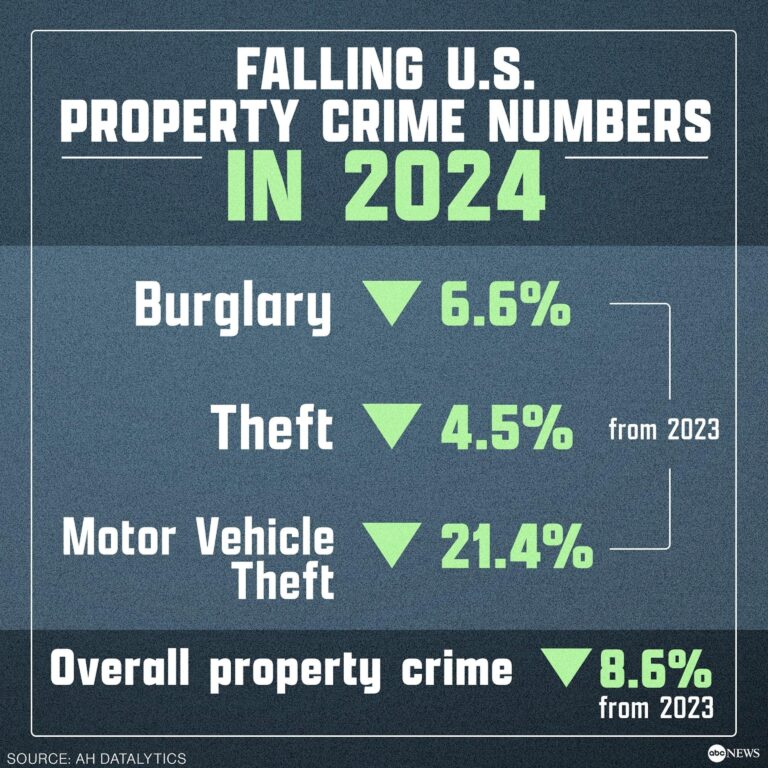The latest FBI report reveals a significant decline in crime rates across the United States in 2024, marking a notable shift in the nation’s public safety landscape. According to the newly released data, reductions were seen in violent crimes, property crimes, and other categories, reflecting ongoing efforts by law enforcement agencies and communities to curb criminal activity. This development comes amid broader discussions on crime trends and policy effectiveness, offering fresh insights into the evolving dynamics of law and order in America.
US Crime Rates See Significant Drop in 2024 FBI Report Reveals
The recently published FBI report highlights a remarkable downturn in crime rates across the United States for the year 2024, a trend largely welcomed by law enforcement agencies and communities alike. Key categories such as violent crime, property crime, and cybercrime have all experienced noticeable reductions. Experts attribute this positive shift to enhanced policing strategies, community engagement programs, and advances in technology aiding crime prevention and investigation.
Highlights from the FBI Crime Report 2024 include:
- A 15% decrease in violent crimes, including homicide and aggravated assault.
- Property crimes fell by nearly 12%, covering burglary, theft, and motor vehicle theft.
- Cybercrime incidents reported show a slight decline, reflecting stronger cybersecurity measures.
| Crime Category | 2023 Cases | 2024 Cases | % Change |
|---|---|---|---|
| Violent Crime | 1,200,000 | 1,020,000 | -15% |
| Property Crime | 6,500,000 | 5,720,000 | -12% |
| Cybercrime | 350,000 | 330,000 | -6% |
Key Factors Driving the Decline in Violent and Property Crimes
Several critical elements have contributed to the significant reduction in both violent and property crimes across the United States, as detailed in the FBI’s 2024 report. Improved community policing strategies have played a pivotal role, fostering stronger relationships between law enforcement and local communities. This approach has enhanced crime reporting accuracy and preventative measures, leading to more effective interventions. Additionally, technological advances such as predictive analytics and increased surveillance capabilities have enabled police departments to anticipate and disrupt criminal activity more efficiently.
Economic shifts also factor heavily into the trends observed. Rising employment rates and enhanced social support programs have alleviated some of the socioeconomic pressures that often drive individuals toward crime. Public health initiatives addressing mental health and substance abuse further complement these efforts, contributing to safer environments. Below is a summary of key drivers highlighted in the report:
| Key Factor | Impact on Crime Rates |
|---|---|
| Community Policing | Improved trust and cooperation |
| Technology & Surveillance | Enhanced crime detection |
| Economic Growth | Reduced socioeconomic drivers |
| Social Support Programs | Mitigated risk factors |
| Public Health Initiatives | Addressed substance abuse and mental health |
Impact of Law Enforcement Strategies on Community Safety Improvements
Recent data underscores the pivotal role that innovative law enforcement strategies have played in the notable decline of crime rates across the United States. By emphasizing community policing and strategic deployment of resources, agencies have enhanced trust and cooperation between officers and citizens. These efforts have resulted in quicker response times and more effective crime prevention tactics, directly contributing to safer neighborhoods. Additionally, targeted interventions addressing chronic hotspots have been complemented by technology-driven approaches such as predictive policing and real-time data analytics. This multifaceted approach has redefined modern policing, fostering improved safety outcomes.
Key elements of these successful strategies include:
- Community Engagement: Building stronger relationships with local populations to encourage active participation in safety initiatives.
- Data-Driven Policing: Utilizing crime reports and analytics to allocate resources efficiently and anticipate criminal activity.
- Collaborative Partnerships: Coordinating efforts with social services and local organizations to address underlying causes of crime.
- Focused Deterrence: Concentrating enforcement on repeat offenders to disrupt criminal networks.
| Strategy | Primary Benefit | Reported Impact (%) |
|---|---|---|
| Community Policing | Increased trust and reporting | 18% |
| Predictive Analytics | Targeted resource deployment | 22% |
| Focused Deterrence | Reduction in violent crime | 15% |
| Cross-sector Collaboration | Addressing root causes | 20% |
Recommendations for Sustaining and Building on Crime Reduction Trends
To maintain the positive momentum in reducing crime rates, it is essential that law enforcement agencies continue to integrate advanced data analytics and community engagement strategies. Prioritizing transparency and accountability not only builds public trust but also enhances cooperation between authorities and communities. Investing in training programs that emphasize de-escalation techniques and cultural competency will help prevent unnecessary confrontations and reduce incidents of violence. Additionally, fostering partnerships with local organizations can create supportive networks that address underlying social issues such as poverty and lack of education—key drivers of criminal behavior.
Policy makers should focus on sustained funding for crime prevention initiatives, while ensuring that resources are allocated efficiently across varied regions and demographic groups. Expansion of mental health services and rehabilitation programs can further reduce recidivism rates, offering offenders constructive alternatives to returning to crime. Below is a brief overview of strategic recommendations for sustaining crime reduction efforts:
- Enhanced community policing: Strengthen relationships through regular neighborhood outreach.
- Technology integration: Utilize predictive analytics and real-time data sharing.
- Investment in education: Address socioeconomic factors contributing to crime.
- Mental health support: Expand access to counseling and rehabilitation.
- Focused funding: Ensure equitable distribution of resources across regions.
| Strategy | Expected Outcome |
|---|---|
| Community Engagement Programs | Higher public trust and cooperation |
| Data-Driven Policing | More targeted crime prevention |
| Rehabilitation Initiatives | Lower recidivism rates |
| Educational Investments | Reduced socioeconomic risk factors |
Closing Remarks
The decline in crime rates reported by the FBI in 2024 marks a significant shift in the landscape of public safety across the United States. While officials and communities alike cautiously welcome this trend, experts emphasize the need for sustained efforts in addressing the underlying factors contributing to criminal activity. As law enforcement agencies and policymakers continue to analyze the data, the coming months will be critical in determining whether this reduction represents a lasting change or a temporary fluctuation. The Al Jazeera team will continue to monitor developments and provide comprehensive coverage on this evolving story.




